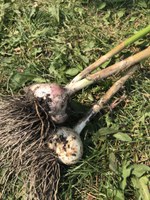Dakota Gardener: Great Garlic!
(Click an image below to view a high-resolution image that can be downloaded)
By Carrie Knutson, NDSU Extension Agent, Grand Forks County
For the past two years, I have tried growing garlic in my garden.
The first year, I had several challenges. The fall was incredibly wet and cold. I also underestimated the amount competition from self-seeded dill plants. I harvested two really small heads of garlic.
I was not discouraged. Remember, a good gardener will kill a plant at least three times and keep trying! My second attempt was a winner. I harvested my garlic this past weekend and was not disappointed.
Garlic is a hardy perennial member of the onion family. Garlic differs from the onion in that it produces a cluster of cloves that makes up the bulb, rather than one large bulb. Garlic also has flat leaves rather than the round, hollow leaves like an onion.
We have two main types of garlic: hardneck and softneck. Hardneck garlic is the hardiest type for us and, as the name implies, it has a stiff neck. Hardneck garlic varieties to try for our area are ‘Music,’ ‘German Extra Hardy,’ ‘Russian Red,’ ‘German Red’ and ‘Spanish Roja.’ Softneck garlic is the kind we typically buy in the grocery store and it doesn’t grow well in our area.
Planting requires some preparation because garlic needs full sun and well-drained soil. You also will want to work in 3 pounds of 10-10-10 fertilizer per 100 square feet before planting.
Cloves are planted in late September or early October. They should be spaced 1 to 3 inches apart and planted 4 inches deep. Cloves will produce roots and the tops also will begin sprouting before the soil freezes.
Garlic should be covered with a mulch layer to protect it from low winter temperatures and soil temperature fluctuations. Typically, cover garlic with a 4-inch layer of clean straw.
Garlic produces thin foliage that is not a good competitor with weeds, so be prepared to do some weeding. The winter mulch will help with weed suppression during the growing season.
Garlic is harvested in mid to late August or when the foliage starts to turn yellow. To prevent any damage, gently dig the tops rather than pulling. Place the entire plant, top and all, on a screen in a well-ventilated location at room temperature for about two weeks. When the plants have dried down, remove the tops about an inch above the bulb.
I am saving the largest cloves from my crop to plant later this fall but I can’t wait to use the smaller cloves in stir-fries and vinaigrettes. Whether you shop local, order online or ask another gardener to share, I hope you try planting garlic your garden this fall. Happy gardening!
For more information about gardening, contact your local NDSU Extension agent. Find the Extension office for your county at https://www.ag.ndsu.edu/extension/directory/counties.
NDSU Agriculture Communication - Aug. 10, 2021
Source: Carrie Knutson, 701-780-8229, carrie.knutson@ndsu.edu
Editor: Ellen Crawford, 701-231-5391, ellen.crawford@ndsu.edu




